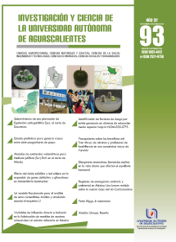Preliminar study to generate crosses among seven potato progenitors
DOI:
https://doi.org/10.33064/iycuaa2024934753Keywords:
Solanum tuberosum, Flowering, Mating systemsAbstract
Mating systems are a prerequisite to characterize potato varieties that are used in breeding programs, seed production programs, as well as to generate, validate, apply and transfer technology. The main objective of the present study was to perform all the possible crossings among seven progenitors, but only 26 crosses were performed of which 12 produced fruit. The best male progenitors were Caesar, Fianna and Orquesta. The best cross was Atlantic x Caesar, followed by Fianna x Caesar (147 and 135 seeds per fruit, respectively).
Downloads
References
• Almekinders, C. J. M., and Wiersema, S. G. (1991). Flowering and true seed production in potato (Solanum tuberosum L.) I. Effects of inflorescence position, nitrogen treatment and harvest date of berries. Potato Research 34:379-388. DOI: https://doi.org/10.1007/BF02360574
• Almekinders, C. J. M. (1991). Flowering and true seed production in potato (Solanum tuberosum L.) 2. Effects of stem density and pruning of lateral stems. Potato Research. 34:365-377. DOI: https://doi.org/10.1007/BF02360573
• Aksoy, E.; Demirel, U.; Bakhsh, A.; Zia, M.A. B.; Naeem, M.; Saeed, F.; Çalışkan, S. and Çalışkan, M. E. (2021). Recent advances in Potato (Solanum tuberosum L.) Breeding. In: Al-Khayri, J.M., Mohan J., S. and Johnsin, D.V. Ed. Advances in plant breeding strategies: vegetable crops. Volume 8: Bulbs, Roots and Tubers. (Pp. 409-488). Springer Nature Switzerland AG. DOI: https://doi.org/10.1007/978-3-030-66965-2_10
• Anisimov, B.V.; Simakov, E.A.; Zhevora, S.V. and Zebrin, S.N. (2021). Production of first and subsequent field generations/classes of original, elite, and reproduction potato seed: Potato breeding using true (botanic) seeds. In: Zhevora, S.V. and Anisimov, B.V. eds. Potato seed production. Pp. 49-60. Springer Nature, Switzerland. DOI: https://doi.org/10.1007/978-3-030-60762-3_5
• Bethke, P. C. and Jansky, S.H. (2021). Genetic and Environmental Factors Contributing to Reproductive Success and Failure in Potato. American Journal of Potato Research. 98:24–41. DOI: https://doi.org/10.1007/s12230-020-09810-3
• Bonierbale, M.W.; Amoros, W.R.; Salas, E. and De Jong, W. (2020). Potato breeding, In: Campos, H., Ortiz. O. (eds.). The potato crop. (pp. 163-217). Switzerland: Springer. DOI: https://doi.org/10.1007/978-3-030-28683-5_6
• Gopal, J. (1994). Flowering behavior, male sterility and berry setting in tetraploid Solanum tuberosum germplasm. Euphytica 72:133-142. DOI: https://doi.org/10.1007/BF00023782
• Gopal, J.; Kumar, V. and Luthra, S. K. (2008). Top-cross vs. poly-cross as alternative to test-cross for estimating the general combining ability in potato. Plant Breeding 127: 441-445. DOI: https://doi.org/10.1111/j.1439-0523.2008.01491.x
• Gopal, J. (2015). Challenges and way-forward in selection of superior parents, crosses and clones in potato breeding. Potato Res, 58:165-188. DOI: https://doi.org/10.1007/s11540-015-9292-6
• Golmirzaie, A. M. and Mendoza, H. A. (1985). Identification of parental lines for development of TPS population. American Potato Journal, 62: 427- 428.
• Grun, P. and Albertin, M.(1966).The inheritance and expression incompatibility in Solanum. Heredity, 21:131-138. DOI: https://doi.org/10.1038/hdy.1966.7
• Hanneman Jr., R. E. (1999). The reproductive biology of the potato and its implication for breeding. Potato Research, 42: 283- 312. DOI: https://doi.org/10.1007/BF02357859
• Howard, H. W. (1970). Genetics of the Potato Solanum tuberosum L., 125 p. London, Logos Press.
• Mendoza, H.A. and Haynes, F.L. (1974). Genetic basis of heterosis in the autotetraploid potato. Theoretical and Applied Genetics. 45:21-25. DOI: https://doi.org/10.1007/BF00281169
• Mendoza, H. A. (1983). Selection of uniform progenies to use TPS in commercial potato production, In: Report 16 of Planning Conference on Present and Future Strategies for Potato Breeding and Improvement. pp:87-97. Lima, Peru, International Potato Center (CIP).
• Molina, J. de D.; Santos, B.M. y Aguilar, B. L. (2004). Guía MIP en el cultivo de la papa. Instituto Nicaragüense de Tecnología Agropecuaria. 7p.
• Montaldo, A. (1994). Cultivo y mejoramiento de la papa. Instituto Interamericano de Cooperación para la Agricultura. San José. Costa Rica. 628 p.
• NIVAP (Nederlands Instituut voor Afzetvebordering van Potaardappelen – Netherlands Potato Consultative Foundation). (2007). Netherlands catalogue of potato varieties. 287 pp.
• Otazu, V. and W. Amoros. (1991). Potato Berry blackening and premature drop due to boron deficiency. Am. Potato J. 68:849-856. DOI: https://doi.org/10.1007/BF02853858
• Pérez, L.D.J.; Rivera, P.A.; Sahagún C.J.; González, H.A.; Landeros, F.V.; Serrato, C.R.; Florentino, V. H.; Ortiz, A. M. (2003). Ciencias Agrícolas Informa. Facultad de Ciencias Agrícolas de la UAEM. (14): 23-28.
• Plaisted, R. L.; Sanford, L.; Federer, W.T.; Kehr, A.E.(1962). Specific and general combining ability for yield in potatoes. American Potato Journal, 39:185-197. DOI: https://doi.org/10.1007/BF02871402
• Tai, G.C.C. (1976). Estimation of general and specific combining abilities in potato. Canadian Journal of Genetic Cytology, 18: 463- 470. DOI: https://doi.org/10.1139/g76-056
• Upadhya, M. D.; Thakur, K.C. and Kadian, M.S. (1985). Influence of genotype and Environment on true potato seed (TPS) quality parameters CIP. Lima, Peru
Downloads
Published
How to Cite
License
Copyright (c) 2024 Claudia Saavedra-Guevara, Delfina de Jesús Pérez-López, Andrés González-Huerta, José Ramón Pascual Franco-Martínez

This work is licensed under a Creative Commons Attribution-NonCommercial-ShareAlike 4.0 International License.
Las obras publicadas en versión electrónica de la revista están bajo la licencia Creative Commons Atribución-NoComercial-CompartirIgual 4.0 Internacional (CC BY-NC-SA 4.0)









